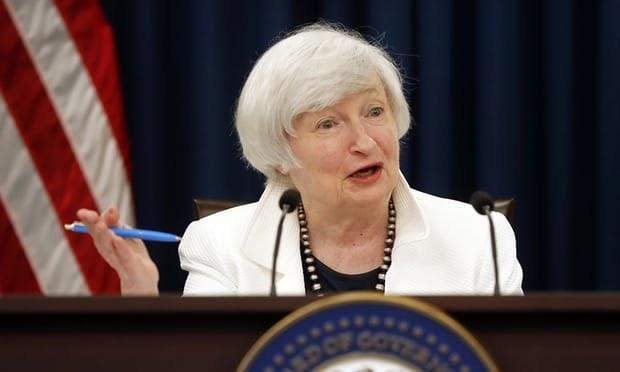
US president Donald Trump is expected to name the new chair of the US central bank before he departs for his 12-day trip to Asia on 3 November.
Janet Yellen, whose first four-year term as chair of the Federal Reserve ends in February, is on the shortlist but whether she remains in the top job is far from certain.
Trump is considering four candidates to replace her: Gary D Cohn, the president’s chief economic adviser; Jerome H. Powell, the only Republican on the Fed’s board of governors; John B. Taylor, a Stanford University economist and Kevin Warsh, a former Fed governor.
“Honestly, I like them all,” Trump said last Tuesday, but singled out Yellen, Powell and Taylor as the most promising contenders.
Verdict takes a look at the what each of the forerunners have to offer.
Janet Yellen
Yellen, the 71-year-old Democrat, has spent almost two decades at the Fed.
How well do you really know your competitors?
Access the most comprehensive Company Profiles on the market, powered by GlobalData. Save hours of research. Gain competitive edge.

Thank you!
Your download email will arrive shortly
Not ready to buy yet? Download a free sample
We are confident about the unique quality of our Company Profiles. However, we want you to make the most beneficial decision for your business, so we offer a free sample that you can download by submitting the below form
By GlobalDataShe was a Fed governor in the mid-1990s, before returning to the US central bank as president of the Federal Reserve Bank of San Francisco in 2004.
Six years later, she became the Fed’s vice chairwoman.
Since Yellen was appointed chairwoman in 2014, US unemployment has steadily declined to 4.2 percent while inflation has remained below 2 percent.
“The economy is humming along,” said Julia Coronado, president of MacroPolicy Perspectives, a New York economic research firm. “The markets are humming along. Given all the other stuff that’s going on, why mess with that?”
Trump said earlier this year that he favoured low interest rates, and although Yellen has increased interest rates, she has done so very gradually.
She has also reduced the bond holdings that were acquired by the Fed after the 2008 financial crisis to revive economic growth.
Last week, Yellen said that the Fed is making “good progress” in shrinking its $4trn portfolio of Treasuries and mortgage backed securities.
The Fed plans to shed $10bn every month during the final quarter of 2017, before increasing that to $10bn every three months until it reaches a monthly rate of $50bn.
Despite Trump’s criticism of “excessive” financial regulation as an impediment to growth, Yellen has not retreated from her position. She has said that it would be foolish to roll back the far-reaching regulations which were introduced in 2008 to avoid another recession.
“The events of the crisis demanded action, needed reforms were implemented and these reforms have made the system safer,” Yellen said in August at the annual Jackson Hole Economic Symposium.
“Already, for some, memories of this experience may be fading — memories of just how costly the financial crisis was and why certain steps were taken in response,” she added, emphasising how post-crisis regulation has strengthened the financial system.
The US treasury secretary, Steven Mnuchin, has said that replacing Yellen would help Trump achieve his deregulation goals.
The last Fed chairman who did not serve a second term was G. William Miller. He was replaced in 1979 after just 17 months.
Jerome Powell
A centrist when it comes to regulation and monetary policy, Jerome Powell is the only Republican on the Fed’s board of governors.
He has emerged as the favourite to replace Yellen, after reports last week suggested the president was “leaning towards” choosing him.
“One factor that favors easier adjustment in [emerging-market economies] is that US monetary policy normalisation has been and should continue to be gradual, as long as the US economy evolves roughly as expected,” Powell told a banking conference earlier this month.
The former investment banker and adviser to George Bush Sr, has argued in favor of rolling back some of the post-crisis Dodd-Frank regulations, specifically rules that constrain bank lending.
Aside from his views on regulation, however, he has a lot in common with Yellen, according to Peter Hooper, chief economist at Deutsche Bank.
“We suspect that a Powell-led Fed would not be a large step away from a Yellen-led Fed and would thus represent policy continuity for markets,” he said.
Tom Porcelli, chief United States economist at RBC Capital Markets, agrees:
Our view is Powell is the G.O.P. version of Yellen, with the added kicker of wanting to reduce regulation.
Powell is, in many ways, the status-quo candidate.
John Taylor
The 70-year-old professor of economics at Stanford University has been critical of the Fed’s response to the financial crisis.
The central bank’s stimulus program raised “serious constitutional issues about which agencies of government are given the authority to appropriate funds,” he said.
In 2009, he warned that the “enormous” increase in bank reserves would see inflation surge.
However, inflation has remained low.
None of the dangers that Taylor prophesied, including financial volatility, came to pass.
A hawk in his economic outlook, Taylor is a proponent of higher interest rates, having developed his own mathematical formula in the early 1990s to guide rate setting.
If introduced however, Taylor’s rule would be at odds with Trump’s wishes to keep interest rates low.
Taylor’s rule dictates that the Fed should have already raised its benchmark rate to around 3.5 percent.
The rate currently sits between 1 percent and 1.25 percent.







